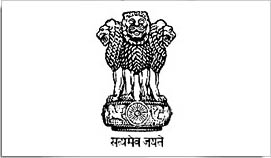An emblem is an image, abstract or representational that epitomizes a concept — e.g., a moral truth, or an allegory.
A national emblem symbolically represents a nation. National emblems may appear on many things such as the national flag, coat of arms, or other patriotic materials.
The emblem of India is an adaptation from the Sarnath Lion on an Ashoka pillar erected by Emperor Ashoka to mark the spot where Gautama Buddha first taught and where the Buddhist religion was born.
The emblem was adopted by the Government as the National emblem of India on 26th January 1950. It is a part of the official letterhead of the Government of India and appears prominently on the diplomatic and national Passports of India. The emblem is also shown on the Indian Currency.
The emblem has four lions standing back to back (only three are visible), mounted on an abacus with a frieze carrying sculpture in high relief of an elephant, a gallping horse, a bull and a lion separated by intervening wheels (chakras). Carved out of a single block of polished sandstone, the Capital is crowned by the Wheel of the Law (Dharma Chakra). The words, "Satyameva Jayate" from Mundaka Upanishad meaning 'Truth alone triumphs', are inscribed below the abacus in Devangari script.

The Indian National Emblem
In the contemporary times, the national emblem of India is a symbol of modern India's reassertion of its ancient commitment to world peace and goodwill.
